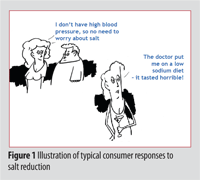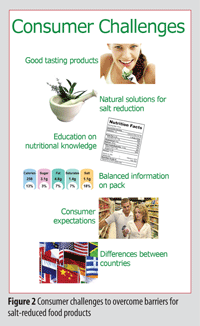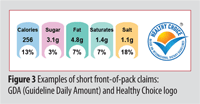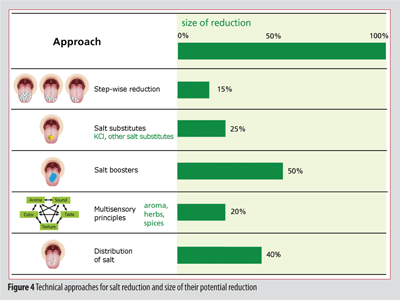Salt reduction and the consumer perspective
Posted: 12 May 2010 | Johanneke Busch, Gerda Feunekes, Beatrijs Hauer and Wilma den Hoed, Unilever R&D Vlaardingen | No comments yet
In recent years, scientific studies have shown that salt intake can cause high blood pressure and associated heart diseases. Conversely, there is clear evidence that significant reductions of salt intake lead to large reductions in blood pressure, heart diseases and strokes1. Other important risk factors for these cardiovascular diseases are body weight, exercise, alcohol intake, smoking and high cholesterol. However, lowering salt intake has become a high priority issue of the WHO (World Health Organisation), with a recommended daily intake of five grams of salt (NaCl) per day (two grams of sodium (Na+))2, whereas current typical daily intakes are 8-12 grams of salt.
In recent years, scientific studies have shown that salt intake can cause high blood pressure and associated heart diseases. Conversely, there is clear evidence that significant reductions of salt intake lead to large reductions in blood pressure, heart diseases and strokes1. Other important risk factors for these cardiovascular diseases are body weight, exercise, alcohol intake, smoking and high cholesterol. However, lowering salt intake has become a high priority issue of the WHO (World Health Organisation), with a recommended daily intake of five grams of salt (NaCl) per day (two grams of sodium (Na+))2, whereas current typical daily intakes are 8-12 grams of salt.
In recent years, scientific studies have shown that salt intake can cause high blood pressure and associated heart diseases. Conversely, there is clear evidence that significant reductions of salt intake lead to large reductions in blood pressure, heart diseases and strokes1. Other important risk factors for these cardiovascular diseases are body weight, exercise, alcohol intake, smoking and high cholesterol. However, lowering salt intake has become a high priority issue of the WHO (World Health Organisation), with a recommended daily intake of five grams of salt (NaCl) per day (two grams of sodium (Na+))2, whereas current typical daily intakes are 8-12 grams of salt.
Sodium (Na+) is the actual nutrient that influences blood pressure. In food products, it is mainly present as salt (NaCl). Hence, one often speaks of salt reduction, where sodium reduction is meant. In this paper, the term salt (NaCl) is primarily used.
The challenge of salt reduction
Approximately 75 per cent of the daily salt intake can be attributed to industrial and restaurant foods. Indeed, the food industry recognises their responsibility with regards to salt content in food products and various salt reduction initiatives have started3. After several years of ‘silent’ salt reduction, Unilever announced its strategy on salt reduction in 2009. Unilever aims to lower the salt level in its products such that consumers can reach a daily intake of six grams of salt by the end of 2010. A further reduction towards a daily intake of five grams of salt is targeted by the end of 2015, conforming to the WHO recommendation. Recent Unilever examples are pasta and sauce side dishes that have been relaunched in Australia (40 per cent reduced salt), the USA (10 per cent) and Canada (25 per cent).
Consumer awareness
Salt reduction is an upcoming issue among consumers. Increasing emphasis is being placed on communication about salt, by initiatives from governments, health organisations and the food industry. It is perhaps unsurprising that when asked in consumer research about low- or reduced-salt products, the main concern for consumers is a loss of taste4,5. At the same time, consumers indicate being interested in reduced salt products because they believe that such products can help to improve their health. Nevertheless, most consumers think that reduced salt products are especially relevant for elderly people and those with health problems4,5 (see Figure 1).


Finland was the first country to initiate a salt reduction program. This was led by the Finnish government in the late 1970s. This initiative led to substantial national media and public attention, as well as the Finnish industry drastically reducing salt levels in many products. The combination of legislated labelling and good consumer communication were useful instruments to reduce salt intake in the population6. Elsewhere in the world, in the past five years, public attention to the health effects of high salt intake has grown massively. For example, the UK, Australia, Canada, Spain and France are countries playing a key role in addressing salt reduction as a public issue.
Consumer challenges
Taste
While the reasons and rationale to reduce salt are clear to most consumers, various consumer challenges need to be tackled to realise good consumer acceptance of salt-reduced food products (see Figure 2). Together with price, taste is the most important driver for consumers to buy a product, whereas health is not high in consumers’ minds. It is also clear that consumers do not want to compromise on taste for the sake of any health benefits (unless they have a particular health condition). This was clearly demonstrated in a consumer survey showing that a considerable number of the people questioned said that they rarely or never give up taste for health benefits; for example, 18 per cent in India or 70 per cent in Western Europe (Health Focus, consumer research study, unpublished). This taste challenge is specifically relevant to salt reduction because salt is such a good taste enhancer and good replacements do not exist.


Natural solutions
Predominantly in Western countries, ‘naturalness’ is seen as equivalent to health. ‘Naturalness’ is associated with ingredients that have not undergone any processing. For example, consumers regard low sodium sea salt and herbs as natural, whereas consumers tend to be suspicious and intolerant of E-numbers (in the EU) or any ingredients that sound ‘chemical’. From this point of view, the usage of potassium chloride as a substitute for salt is not recommended because it has an E-number and, therefore, a negative connotation. In contrast, consumers have a very positive view of ‘natural ingredients’ like herbs, spices and natural salt boosters. Hence, such consumer beliefs drive the need for natural solutions.
Nutritional knowledge
In general, consumers have limited knowledge about the nutritional value of food products, although higher educated people tend to know more about this topic. Nevertheless, most consumers are simply not interested in the nutritional information of their diet. Related to this, consumer studies show that people are not motivated to reduce their salt intake, unless they know that they have a health condition5. Hence, consumers should be encouraged to read nutritional information. The industry can help here by making the nutritional information easy to interpret and understand.
Information on pack
In the last couple of years, extensive guidelines and legislation have been made concerning the communication of nutritional information on food products. Therefore, most food companies communicate the nutritional value of their products to consumers, for example, through back-of-pack nutritional information, but also via front-of-pack labelling. An advantage of simple front-of-pack labels is that they can be effective in a shopping environment where quick decisions are made. In particular, it can help those consumers who do not elaborate deeply on nutritional information. For those people, an evaluative front-of-pack label can help consumers to make more accurate health evaluations about the product without having to read the back-of-pack information. This was supported by data from Van Trijp et al.7 investigating how different consumer segments would elaborate on front and back-of-pack information. They found that front-of-pack short claims (for instance, see Figure 3) in combination with more detailed back-pack information is a good way to reach different types of consumers. For example, taste-focused consumers may only glance at the front-pack claim, whereas the health-focused consumers want more elaborate information. Similarly, Wansink8 found that short health claims on the front of a package with full health claims on the back leads to higher credibility for health claims with consumers. Taken together, simple front-of-pack labels can help consumers to buy those products that contain less salt.


Consumer expectations
Consumers’ actual taste experience is based on more than just the food product. This can be illustrated nicely by the fact that a red-coloured vanilla flavoured milkshake is often said to taste like strawberry, whereas the same flavoured milkshake, coloured yellow, is said to taste like banana. In a similar way, nutritional labels and other on-pack communication can influence consumers’ taste expectations, but also the actual taste experience and liking of a product10. In line with this, we investigated how front- of-pack labels, in combination with other health labels like ‘now with reduced salt’, affect expectations, liking, and desire of a soup among regular soup eaters9. The soup that was accompanied by the label ‘now with reduced salt’ was perceived as less salty than the other soups even though all the soups were exactly the same. This implies that consumers might not try such a low-salt product. This stresses the importance of effective communication around salt reduction, for example, by ensuring good taste of the reduced salt product.
Differences between countries
As mentioned above, salt is becoming a hot topic among consumers and the number of countries where campaigns have started on the health effects of too much salt is growing. In Finland and the UK, where governments and health organisations campaign actively on salt, awareness is high. Conversely, in Germany, there is not much active communication around salt and the consumer awareness is low. Rozin et al.11 showed that high salt content of products is not always seen as a health risk in different countries. For example, in France, food is mostly associated with pleasure rather than with health, whereas German consumers do not worry about their salt intake and women in the United States tend to prefer low salt alternatives. These differences between countries can be attributed to both cross-cultural differences and the extent of awareness on salt.
Technical approaches to reduce salt
Step-wise
With these consumer challenges in mind, a number of technical hurdles will need to be solved. A number of common approaches can be taken to reduce salt in food products (see Figure 4). The first, and preferred, approach is to gradually reduce the salt content in products in small steps. Indeed, consumers’ taste can shift to products with a lower salt content and less intense (salty) taste, after several consumption occasions12. This shift in preference is only valid for the specific product type (e.g. soup) and does not extend to the full diet. Interestingly, further salt reductions are accepted by consumers only if they are done in these small steps. Furthermore, the size of the reduction steps and the speed with which each step is introduced is product dependent and determined by consumption frequency (e.g. daily versus weekly). In contrast, when products are drastically reduced in salt, there is a large risk of losing consumers switching to higher salt alternatives. This leads to an important implication that the step-wise approach is most effective when it is conducted industry-wide with a whole food segment being lowered in salt simultaneously (e.g., the complete soup segment). Finland and the UK are countries where the step-wise approach has been successfully executed.


Salt substitutes
One problem of step-wise reduction is that there are limits to the amounts of salt that can be taken out of products in order for them to remain palatable and liked. Therefore, salt substitutes are the second technical means to further reduce sodium levels in products. The key point of these substitutes is that they do not contain sodium, but that they do deliver a salty taste. Typical substitutes are mineral salts, such as potassium chloride (KCl). However, potassium chloride has an E-number and sounds ‘chemical’, which makes is less attractive to consumers. Another serious limitation of this substitute is that it brings an undesired bitter and metallic off-taste. As a result, commercial salt substitutes are mostly marketed in combination with different types of bitterness maskers. Their applicability in food products is often much lower than the amounts they are advertised for.
Salt boosters
To meet the WHO recommendation, some products need salt reductions of more than 30 per cent. As step-wise reductions take time and salt substitutes have their limitations, new natural ingredients are desired. In particular, natural ingredients that can trigger or increase the sensitivity of the sodium channel receptor are of interest. These are the so called ‘salt boosters’. Hence, the third approach is trying to find such ingredients, for example, by using cellular receptor assays. This is currently scoped by specialised food and ingredient companies.
Multisensory principles
Salt is known for its flavour enhancing capacity (it is a natural flavour enhancer) and reduction of this ingredient has a negative impact on taste. Therefore, the use of aromas, herbs and spices helps to compensate for that functionality. Thus, the fourth approach is to include extra herbs and spices into salt-reduced products in order to keep the good taste quality3,13. The natural perception of such ingredients makes them an attractive tool.
Distribution of salt
Finally, we would like to mention a somewhat different approach to salt reduction, which is via optimising the salt distribution within a food product. An interesting example of this is to contrast high and low salt elements within a product, such as a lower-salt soup with salted rather than unsalted meat pieces, or bread or meat with high and low salt-containing layers14,15.
Conclusions
After the WHO published its guidelines to reduce salt intake to five grams a day, many salt reduction initiatives have started. Together with that, consumer and technical challenges have become clear. The most important one is that good taste of salt-reduced products should be ensured. Communication campaigns of governments and health organisations will improve consumer awareness about the health effects of too much salt. Besides this, effective on-pack communication can help and improve compliance with a lower salt intake. However, all of this also stands with good tasting low-salt products. The food industry has a large responsibility here finding and implementing consumer attractive alternatives for salt, like step-wise reduction and natural salt options.
References
- Strazzullo, P., Cappuccio, F.P., Salt intake, stroke, and cardiovascular disease: metaanalysis of prospective studies. Brit. Med. J. 339, 1291-1298, 2009.
- World Health Organisation. Reducing salt intake in populations. Report of a WHO Forum and Technical Meeting. Geneva, Switzerland, WHO Document Production Services, 2007.
- Dötsch, M., Busch, J., Batenburg, M., Liem, G., Tareilus, E., Mueller, R. Meijer, G. Strategies to Reduce Sodium Consumption: A Food Industry Perspective, Crit. Rev. Food Sci. Nutr. 49: 10, 841- 851, 2009.
- Walsh, C. Consumer responses to low-salt food products. In: Reducing Salt in Foods: Practical Strategies. Kilcast, D., Angus, F., Eds., Woodhouse Publishing Limited. 124-133, 2008.
- Purdy, J., Armstrong, G. Dietary salt and the consumer: reported consumption and awareness of associated health risks. In: Reducing Salt in Foods: Practical Strategies. Kilcast, D., Angus, F., Eds., Woodhouse Publishing Limited. 99-123, 2008.
- Pietinen, P., Valsta, L.M., Hirvonen, T., Sinkko, H. Labelling the salt content in foods: a useful tool in reducing sodium intake in Finland. Public Health Nutr. 11, 335-340, 2008.
- VanTrijp, H., van der Lans, I.A. Consumer perceptions of nutrition and health claims. Appetite, 48, 305-324, 2007.
- Wansink, B. How do front and back package labels influence beliefs about health claims? J. Cons. Aff. 37, 305-316, 2003.
- Liem, D.G., Zandstra, E.H. Influence of nutritional messages front of pack on consumers’ perception of soup. Presented at Nutrition Society of Australia Meeting, Newcastle, Australia, 8 – 11 Dec. 2009.
- Tuorila, H., Meiselman, H.L., Bell, R., Cardello, A.V., Johnson, W. The role of sensory and cognitive information in the enhancement of certainty and liking for novel and familiar foods. Appetite 23, 231-246, 1994.
- Rozin, P., Fischler, C., Imada, S., Sarubin, A., Wresniewski, A. Attitudes to food and the role of food in life in the U.S.A., Japan, Flemish Belgium and France: possible implications for the diet-health debate. Appetite 33, 163-180, 1999.
- Bertino, M., Beauchamp, G. K., Engelman, K. Increasing dietary salt alters salt taste preference. Physiol Behav, 38, 203-213, 1986.
- Lawrence, G., Salles, C., Septier, C., Busch J., Thomas-Danguin T. Odour-Taste interactions: A way to enhance saltiness in low salt content solutions. Food Qual. Pref. 20, 241-248, 2009.
- Busch, J.L.H.C., Keulemans, C., van den Oever, G.J., Reckweg, F. Food composition. Patent application. WO/2008/074606.
- Stieger, M.A., Bult, J.H.F., Hamer, R.J., Noort, M.W.J. Food product with inhomogeneous tastant bulk distribution and method for making such food product. Patent application. WO/2009/108057.









